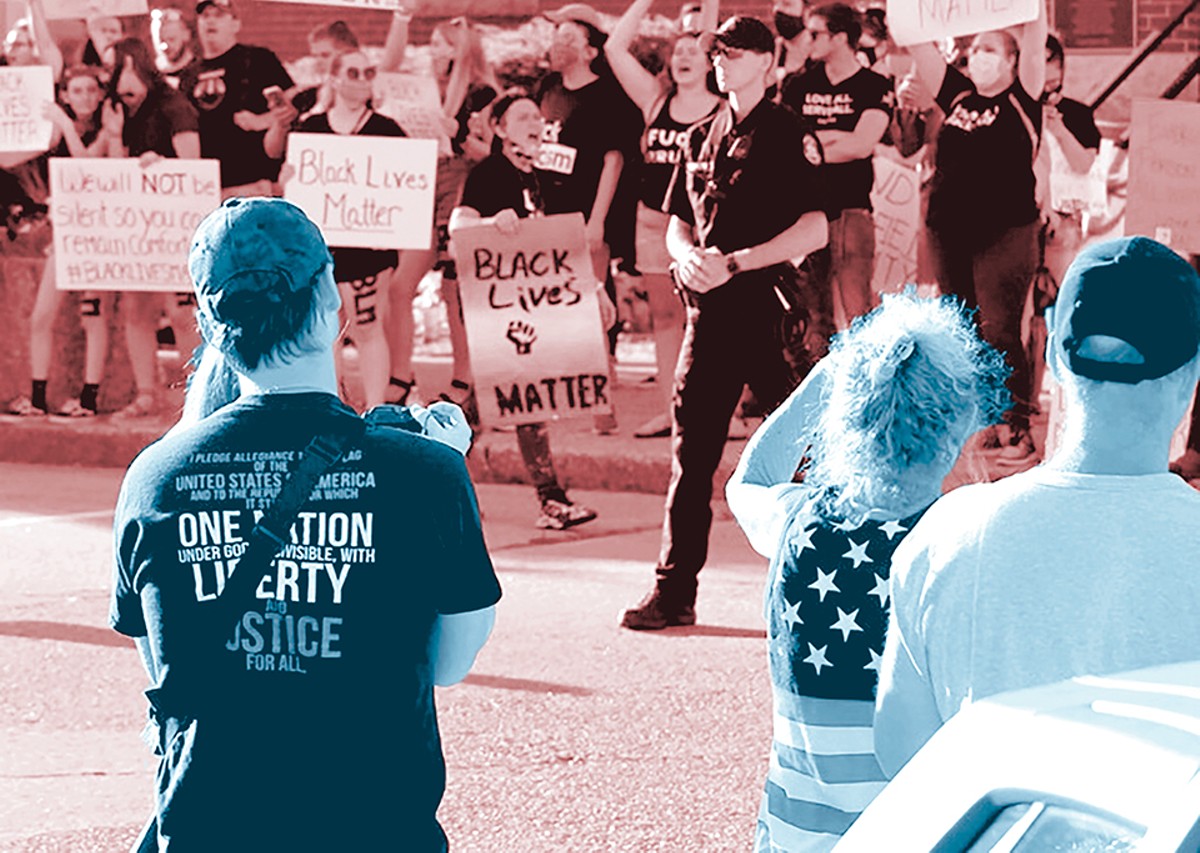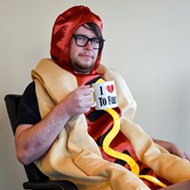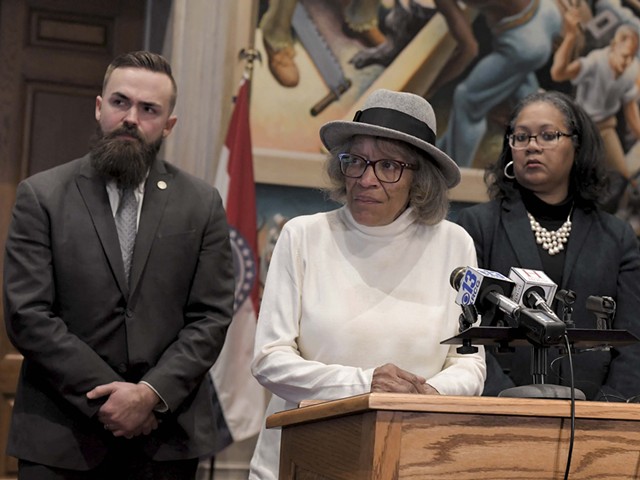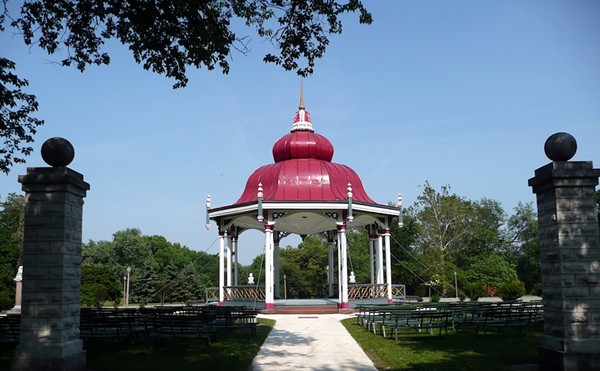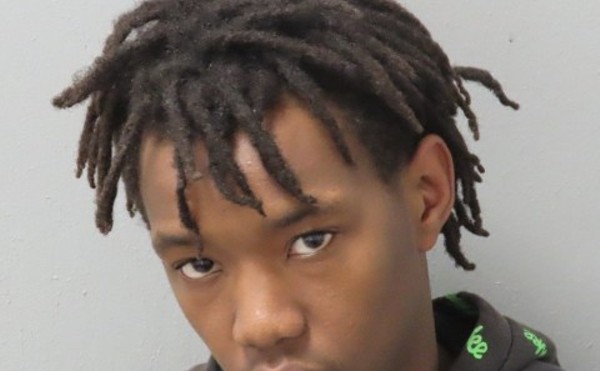
By all accounts, the protest in Fredericktown on July 10 was a much tamer affair than the one held in June.
Far fewer counterprotesters showed up at the scene, though the number of guns remained roughly the same, mostly in the hands of the Three Percenters and the Boogaloo Bois — both groups appeared to have brought in more of their members in response to what they'd seen last time.
There were still some tense and disheartening moments. Hamlin says he saw a man dressed in an American-flag shirt bend down and address his young children, gesturing to the protesters and saying, "Look how stupid Black people are." That same man also tried to get his kids to flip off a photographer, Hamlin says. In a video Hamlin shared with the RFT, the man can be seen mocking protesters' chants while his excruciatingly bored children stand at his feet. One grabs him by the arm at one point and tries to pull him away to leave.
Dorsey says he had a drink thrown at him by a belligerently drunk man who was being escorted away from the scene.
"From what I've been told he had passed out or something. But the whole entire time he was just yelling at us," Dorsey says. "He was saying ‘Blacks are wack,' and he kept saying stuff like that. And he's being escorted to leave, and I just see him gearing up to throw the drink, his arm's cocked back, and something inside of me said, ‘That's coming right at me.’ And I haven't said anything to this man. And he threw it at me, and luckily I kicked it down — I kicked it out of the air and it bounced back up and I caught it and I just gave it to the cops."
Dorsey also spotted a couple of new, rather head-scratching flags waved by some at the event, including a black and blue Confederate flag with a blue line through the middle of it, as well as a half-American, half-Confederate flag hybrid.
“And you guys get mad at us for holding an upside-down flag," Dorsey says. "That's just contradicting everything you guys say about the flag."
But, all things considered, it was far less intense than the June protest. Hindrichs says there was also less screaming between the two groups. She says MOSA organizers took steps in advance to ward off confrontation, instructing protesters not to respond to every insult hurled in their direction, and to instead focus on the task at hand.
“If somebody calls you a bitch, then you take it. You don't have to have those arguments," she says. "And I think when we got that message through to people, that we are there to relay a message and sometimes what we're doing in between that is not productive, then it started to get better and there were less confrontations. And there was more ability to cross the line and reach out to people and talk to people."
MOSA organizers came armed with talking points and pamphlets to distribute as well. Dorsey says they designated a tree in the area to be the spot that people who wanted to debate could go to do so. That way, instead of just shouting across the street at one another, people could get together and talk their differences out.
"And people were actually having debates and listening to one another and actually kind of coming together," Dorsey says.
Johnson was on the scene again as well, Hamlin confirms, but this time he didn't bring a PA system — instead, he had some conversations with some of the protesters, no longer attempting to drown them out with his own speakers.
A few posts on Johnson's Facebook page, in reply to someone who was asking how the protest went, shed some light on his view of those discussions.
“They were pretty peaceful. I had several great conversations. Wish I had more answers but it was productive," he wrote in one post, before noting a conversation with one specific woman in another post. "I told her I would be praying for her. She was a sweet girl. Their hearts seem to be in the right place. Some good people in the movement. I just don't line up with them politically."
In Hamlin's view, a crucial difference between July's protest and June's is that July's protest didn't have a large group of counterprotesters high on right-wing fantasies of lawless protesters spoiling for a fight. Many of the townsfolk that had attended the first event saw that the protesters weren't rioting or hurting anyone, Hamlin figures, so they opted to stay home.
“I do believe that maybe some of them legitimately thought that there could have been some sort of riot or whatever, depending on what it is they see, but I do think a lot of them literally just kind of came out to be combative," Hamlin says of June's protest. "Whether or not they wanted to save their town, they just wanted to be combative. But none of the protesters wanted to be combative. And I think that that also helped a lot of the counterprotest lose steam, was knowing that if they came out, no matter how aggressive they were gonna be, nobody was gonna respond to that. So anybody who was looking for maybe an altercation or a fight, most of those people didn't come back because they knew it wasn't gonna happen."
Dorsey's assessment is largely the same.
“I think it was more that they realized we weren't there to cause a riot; we were there to make a change and educate people," he says. "And I guess they're like, ‘OK, maybe they're not as bad as we thought.' So I guess people came into the mindset of wanting to listen and maybe change."
With July's protest so carefully regulated and organized as MOSA continues to hone its tactics, Hindrichs agrees that they were simply better able to get people to listen to what they had to say. And that's already paying dividends. Hindrichs says the group has since had a number of people reach out to them through the group's Facebook page, as well as some of the pages of the individual organizers, to learn more of what they're all about.
“And I think that's great, because it gets us out of that situation of high stress, tensions being thick, and I think with how the protest went it was easier for people to reach out to us afterwards without feeling threatened," she says.
All told, it's heartening for Dorsey, a young organizer who just wants the best for his hometown.
"I feel like change is coming," he says. "And I think people are finally listening instead of just writing us off."

